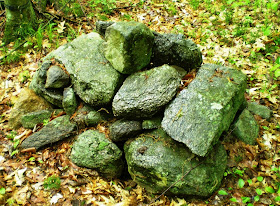Charlie Crowell writes: “This is Watertown’s WWI Memorial on
the triangular green next to the old Town Hall. This photo is from about 1969. This
boulder was originally located off Old Baird Road which runs from Hamiltion
Avenue across to Woodbury Road. Much of the road is abandoned and impassable
today.
Before being used as a monument, this stone was known as
“balancing rock.” At its original site, it sat on top of a rock outcropping and
was so finely balanced that a small child could push it and to would rock back
and forth, but it couldn’t be knocked over. The seemingly precariously balanced
boulder was left in that position by the last ice age. The process of dragging
the rock to its present site was grueling and laborious. It was done using
horses.
In the background you can see one of the old Heminway
mansions on Main Street, now owned by the Methodist Church."
Tim MacSweeney: A Balanced Boulder (in its original
"found" setting) in Native American Ceremonial Stone Landscape terms
- a Drum or Signal Stone if it made a sound when set into motion, like many
found throughout the Northeast. What is your source for this story? I'd like to
pass it along to Dr. Hoffman (as part of CT Cluster #3 (the Nonnewaug Cluster):
https://www.arcadiapublishing.com/Products/9781634990493
Charlie Crowell (to Tim MacSweeney): Tim, this story was
told in the Town Times, sometime in the 50s or maybe even the late 40s. It was
also told back when the project was undertaken in the 20s in the Waterbury
papers. Sorry but I don’t have the stories readily available.
Charlie Crowell (to Al Conley): Richard Sperry, owner the land where the
boulder originally sat, wanted to keep it as a balancing rock even after it was
moved and set up as a monument. He thought engineers could handle the job, but
it never happened.
Tim MacSweeney (to Charlie Crowell): An imaginative investigator might wonder if it is set up on a flat stone - or even a piece of the bedrock removed from the original location near Old Baird Road!
In its original location, it would have been and continue to
be considered a Sacred Stone by the Paugussett: https://www.facebook.com/The-Golden-Hill-Paugussett-Indian-Reservation-165294113670095/
From: "Stone Prayers" Curtiss Hoffman page 90.









































